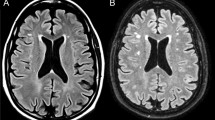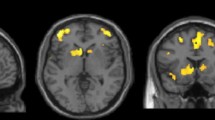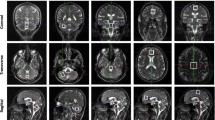Abstract
Introduction
Hereditary spastic paraplegia with thin corpus callosum (HSP-TCC) is a complicated form of autosomal-recessive hereditary spastic paraplegia. Characteristic clinical features comprise progressive spastic gait, cognitive impairment, and ataxia. Diagnostic MRI findings include thinning of the corpus callosum and non-progressive white matter (WM) alterations.
Methods
To study the extent of axonal involvement, we performed localized proton magnetic resonance spectroscopy (MRS) of the cerebral WM and cortical grey matter (GM) in a patient with HSP-TCC at 20 and 25 years of age. The second investigation included diffusion tensor imaging (DTI).
Results
While MRS of the GM was normal, affected WM was characterized by major metabolic alterations such as reduced concentrations of N-acetylaspartate and N-acetylaspartyl-glutamate, creatine and phosphocreatine, and choline-containing compounds as well as elevated levels of myo-inositol. These abnormalities showed progression over a period of 5 years. DTI revealed increased mean diffusivity as well as reduced fractional anisotropy in periventricular WM. The metabolic and structural findings are consistent with progressive neuroaxonal loss in the WM accompanied by astrocytic proliferation—histopathological changes known to occur in HSP-TCC.
Conclusion
Our results are in agreement with the hypothesis that the primary pathological process in HSP-TCC affects the axon, possibly due to impaired axonal trafficking.



Similar content being viewed by others
References
Iwabuchi K, Yagishita S, Amano N, Kosaka K (1991) A new type of complicated form of hereditary spastic paraplegia showing mental deterioration, quadriplegia with muscular atrophy, sensory disturbance, extrapyramidal disorders and epilepsy (in Japanese). Rinsho Shinkeigaku 31:945−952
Tang BS, Chen X, Zhao GH, et al (2004) Clinical features of hereditary spastic paraplegia with thin corpus callosum: report of 5 Chinese cases. Chin Med J (Engl) 117:1002–1005
Shibasaki Y, Tanaka H, Iwabuchi K, et al (2000) Linkage of autosomal recessive hereditary spastic paraplegia with mental impairment and thin corpus callosum to chromosome 15A13-15. Ann Neurol 48:108–112
Casali C, Valente EM, Bertini E, et al (2004) Clinical and genetic studies in hereditary spastic paraplegia with thin corpus callosum. Neurology 62:262−268
Okubo S, Ueda M, Kamiya T, Mizumura S, Terashi A, Katayama Y (2000) Neurological and neuroradiological progression in hereditary spastic paraplegia with a thin corpus callosum. Acta Neurol Scand 102:196–199
Ohnishi J, Tomoda Y, Yokoyama K (2001) Neuroradiological findings in hereditary spastic paraplegia with a thin corpus callosum. Acta Neurol Scand 104:191–192
Brockmann K, Simpson MA, Faber A, Bönnemann C, Crosby AH, Gärtner J (2005) Complicated hereditary spastic paraplegia with thin corpus callosum (HSP-TCC) and childhood onset. Neuropediatrics 36:274–278
Frahm J, Michaelis T, Merboldt KD, Bruhn H, Gyngell ML, Hänicke W (1990) Improvements in localized proton NMR spectroscopy of human brain. Water suppression, short echo times, and 1 mL resolution. J Magn Reson 90:464–473
Natt O, Bezkorovaynyy V, Michaelis T, Frahm J (2005) Use of phased array coils for a determination of absolute metabolite concentrations. Magn Reson Med 23:3–8
Provencher SW (1993) Estimation of metabolite concentration from localized in vivo proton NMR spectra. Magn Reson Med 30:672–679
Pouwels PJ, Brockmann K, Kruse B, et al (1999) Regional age dependence of human brain metabolites from infancy to adulthood as detected by quantitative localized proton MRS. Pediatr Res 46:474−485
Nolte UG, Finsterbusch J, Frahm J (2000) Rapid isotropic diffusion mapping without susceptibility artifacts: whole brain studies using diffusion-weighted single-shot STEAM MR imaging. Magn Reson Med 44:731−736
Rieseberg S, Küntzel M, Merboldt KD, Frahm J (2005) Diffusion tensor imaging using partial Fourier single-shot stimulated echo acquisition mode magnetic resonance imaging with projection onto convex subsets reconstruction. Magn Reson Med 54:486–490
Cheng LL, Ma MJ, Becerra L, et al (1997) Quantitative neuropathology by high resolution magic angle spinning proton magnetic resonance spectroscopy. Proc Natl Acad Sci U S A 94:6408−6413
Bjartmar C, Battistuta J, Terada N, Dupree E, Trapp BD (2002) N-acetylaspartate is an axon-specific marker of mature white matter in vivo: a biochemical and immunohistological study on the rat optic nerve. Ann Neurol 51:51−58
Griffin JL, Mann CJ, Scott J, Shoulders CC, Nicholson JK (2001) Choline containing metabolites during cell transfection: an insight into magnetic resonance spectroscopy detectable changes. FEBS Lett 509:263−266
Hanefeld F, Brockmann K, Pouwels P, Wilken B, Frahm J, Dechent P (2005) Quantitative proton MRS of Pelizaeus-Merzbacher disease: evidence of dys- and hypomyelination. Neurology 65:701−706
Frahm J, Hanefeld F (1997) Localized proton magnetic resonance spectroscopy of brain disorders in childhood. In: Agranoff B, Suzuki K (ed) Magnetic resonance spectroscopy and imaging in neurochemistry. Advances in neurochemistry, vol 8. Plenum Press, New York, pp 329−402
Brand A, Richter-Landsberg C, Leibfritz D (1993) Multinuclear NMR studies on the energy metabolism of glial and neuronal cells. Dev Neurosci 15:289–298
Wakabayashi K, Kobayashi H, Kawasaki S, Kondo H, Takahashi H (2001) Autosomal recessive spastic paraplegia with hypoplastic corpus callosum, multisystem degeneration and ubiquitinated eosinophilic granules. Acta Neuropathol (Berl) 101:69–73
Winner B, Uyanik G, Gross C, et al (2004) Clinical progression and genetic analysis in hereditary spastic paraplegia with thin corpus callosum in spastic gait gene 11 (SPG11). Arch Neurol 61:117–121
Crosby AH, Proukakis C (2002) Is the transportation highway the right road for hereditary spastic paraplegia? Am J Hum Genet 71:1009–1016
Patel TB, Clark JB (1979) Synthesis of N-acetyl-l-aspartate by rat brain mitochondria and its involvement in mitochondrial/cytosolic carbon transfer. Biochem J 184:539–546
Baslow MH (2003) N-acetylaspartate in the vertebrate brain: metabolism and function. Neurochem Res 28:941–953
Acknowledgements
We acknowledge the grant support of the Volkswagen Foundation of the Federal State of Lower Saxony. S.D.-K. was supported by the German Bundesministerium für Bildung und Forschung (01GM0309).
Conflict of interest statement
We declare that we have no conflict of interest.
Author information
Authors and Affiliations
Corresponding author
Rights and permissions
About this article
Cite this article
Dreha-Kulaczewski, S., Dechent, P., Helms, G. et al. Cerebral metabolic and structural alterations in hereditary spastic paraplegia with thin corpus callosum assessed by MRS and DTI. Neuroradiology 48, 893–898 (2006). https://doi.org/10.1007/s00234-006-0148-2
Received:
Accepted:
Published:
Issue Date:
DOI: https://doi.org/10.1007/s00234-006-0148-2




